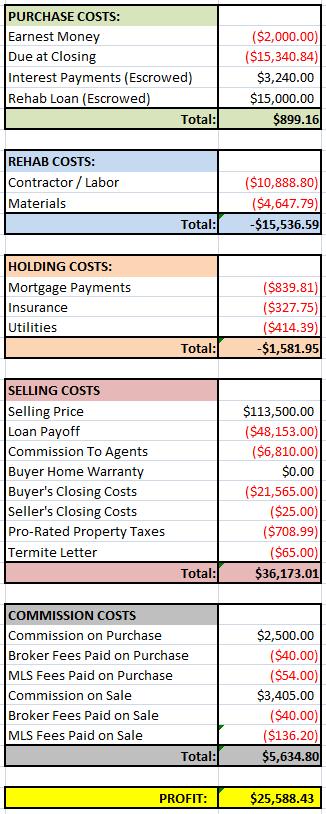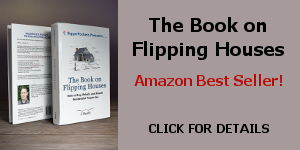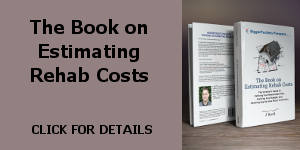We closed on the sale The Hat Trick House today. Below is a final analysis of the deal, including financial results and statistics…
This was a tremendously smooth deal and an easy closing, which was surprising given that the buyer used a lending program I’d never heard of before (NACA). As I mentioned in a previous post, NACA is for borrowers with less-than-stellar credit, and relatively low income. When I saw the closing docs today, I was even more amazed. NACA allows buyers to use seller paid costs to buy down the interest rate on the loan, providing low loan payments. In the case of our buyer today, her 30-year fixed interest rate was .125% (yes, an eighth of a point!).
The buyer ultimately got the house for about $92K (a $113K purchase price minus $21K in seller paid closing costs), but given that interest rate, with all taxes and insurance included, her monthly payment was under $500 per month! Unbelievable. Even more unbelievable, the total interest on the loan, over the entire 30 year term, is only about $2400. Compare that to a typical 5.5% interest rate 30-year fixed loan, where the buyer will end up paying as much in interest as the amount of the loan (so, a $100,000 loan will ultimately cost $200,000 to repay).
There are some restrictions though. For example, the buyer can never rent the house out as an investment, and she has to do some “community service” (I’m not sure exactly what qualifies) as part of the NACA process. According the closing attorney today, less than 1% of all NACA borrowers default on their loan, which means this program is doing a much better job of screening applicants (and helping them) than the rest of the lending industry.
Anyway, on with the analysis…
Timelines
This was a pretty typical project in terms of the timeline. It was a quick rehab that we dragged out a bit because we had other projects going on, and then we were able to put it under contract right around the 90 day mark. While it wasn’t an FHA buyer in this case, I’m always happy when we can get a house under contract by the three month mark, as that’s the minimum turnaround time for an FHA purchase.
Here are the key timeline milestones:
- Purchase Offer Date: 4/1/2009
- Purchase Closing Date: 4/20/2009
- Rehab Completion Date:6/4/2009
- Sale Listing Date: 6/5/2009
- Sale Contract Date: 7/16/2009
- Sale Closing Date: 8/17/2009
This closing was supposed to happen a week ago, so while we held the house for a total of 119 days, we probably could have shortened it to 112 days had we been more persistent.
Financials
We bought the property for $45,000. We sold the property for $113,500, but paid over $21,500 in closing costs to the buyer. It was a relatively small rehab for us (about $15K), and everything else about the project was pretty standard.
Here is the breakdown of financials for this project:

In terms of our profit, I’m very happy about making over $25,000 on this one. When we first purchased the property, I was pretty sure that we could hit our $20K profit target, but there were times during the project when I was concerned it might sit on the market for a while, or it might have difficulty in appraising for the sale price.
In terms of ROI, my total investment into this property was just under $14K; this puts my ROI at over 185%, and adjusted for the time we held the property, our annualized ROI is right about 570%. As usual, not bad on our ROI!
Final Statistics
Here are just some of the final statistics that I’ve been tracking for all my projects, and that summarize the success/failure of each project pretty well:
- From Offer to Purchase Time: 19 Days
- Rehab Time: 44 Days
- Selling Days on Market: 41 Days
- Selling Close Time: 32 Days
- Total Hold Time (Close to Close): 119 Days
- Total Profit: $25,588.43
- Return on Investment (ROI): 185.24%
- Annualized ROI: 568.18%




Man I hate you 😀 — I’m stuck with my latest flip after it’s been sitting on the market for 3 months. I got it priced down so aggressively I’ll be lucky to make $10k on it if I even do sell it… And here you are doing $25k deals left and right…. Once again, I reitterate — I hate you 😉 hahaha
-Hakrjak
I calculated your total cost to be $34,459.38 (purchase, rehab and holding costs) so I am not sure how the loan payoff went up to $48,153. Obviously that did not include the $21,565 buyer’s “closing costs” you paid, which I have a hard time seeing how you did that without the lender objecting to it being essentially a loan from you to the buyer or an inflation of the sale price or some other form of what a lender would view as improper price manipulation. So my questions are: 1.) how did you get the lender to agree to your doing that in the name of it being closing costs (I’d REALLY like to see the HUD-1 on this one) and 2.) What constituted the $13,693.62 difference between your stated costs and the loan payoff?
I am not suggesting that you did anything improper here – just curious about these two issues.
Hi Bryant –
Always happy to share more details!
1. I’m not sure exactly what the question is here…but it sounds like you’re asking how the buyer was able to get $21K in closing costs and then use that money to buy the loan down? Is that correct? Assuming so, the answer is that this is specifically how the loan program that the buyers used (NACA) is intended to work. Check out http://www.naca.com. They work with some of the big lenders (this deal was funded by Bank of America), and the program is set up such that the seller pays extraordinary high closing costs, most of which go to buy the loan interest rate down. So, the purchase offer is generally higher than the list price on these deals. The house is then appraised like any other loan, but NACA is willing to finance up to 110% of the appraised value, since the appraisal oftentimes comes in lower than the purchase offer (which again, is generally higher than list price).
Does that make sense? If not, let me know where I lost you, and I’m happy to try to explain a bit better.
By the way, the HUD is very simple. The purchase price (line 401) was $113,500. Settlement charges to seller (line 502) was $28,375, which included the $21,565 in seller paid closing costs and $6810 in agent commissions. Loan payoff (line 504) was $48,153. Then there was $25 in seller closing costs and $708.99 in pro-rated property taxes.
$113,500 – $28,375 – $48,153 – $25 – $708.99 = $36,238.01, which is what my check was for. We’ll get another check for $3405, which is the commission my wife gets for being the listing agent (minus some fees).
2. Let me explain how my loan works. My lender finances both acquisition and rehab costs for the property, minus 20% that I’m required to put down. The purchase price of this property was $45,000 and the rehab costs that my lender paid were $15,000, for a total investment of $60,000. I pay 20% down, and they finance the other 80%, or exactly $48,000 in this case. The extra $153 was the pro-rated part of my next interest payment that would have been due in a couple weeks.
Does that make sense?
To explain a bit more, you’ll notice my total payment for the acquisition of this property was $2000 in earnest money plus $15,340 at closing, for a total of about $17,340. This constitutes my 20% down payment ($12,000) plus my purchase closing costs and loan fees ($2100) plus one year of interest payments that my lender escrows as security ($3240).
Let me know if you’d like me to clarify any of that…
J Scott, What did the property appraise for? If you had sold it via an FHA or USDA what do you think you could have gotten for the house?
Also, do you have a drawing account with your lender as far as rehab cost, or do they just chunk it out to you? I’ve always been a cash buyer and rehabber and wondered how the lenders might treat this situation.
Jingle
Nice work, yet again. Seems so simple: Buy it correctly, rehab quickly and sell for a profit. Notice I said simple not easy. Just think you only need to do about 20 of these in the next 360 days to hit your goal. So my math says you will need to be completeing one every 18 days or so. That sounds like a lot of fun (and a fair amount of hard work).
Jingle –
It appraised for $114K, which is crazy. We tried our typical sweet-talking of the appraiser and it must have worked, as I was assuming the appraisal was going to come back around $100-105K. We were actually really concerned about the financing going through, even though they finance up to 110% of the appraised value (I still didn’t think it would appraise for enough).
Also, the appraiser was hand-selected by NACA (the lending program). So, it’s quite possible that the appraiser was trying really hard to get the appraisal high enough.
The nice thing is that we just got The Red Garage House (in the same subdivision) under contract for $103K, so this will be a great comp to ensure that one appraises. We actually lost our first contract on that one because one of the appraisals came in very low.
As for the lender paying rehab costs, I submit a spreadsheet before the purchase listing the rehab items and requested amounts. Then, during rehab, I let them know when I’m ready for an inspection. The inspector comes out, looks at the house, and checks off the things that were completed. They deposit the money for the completed items in my checking account the next day. I can get inspections as often as I like, but I tend to just do them once at the end of the project (I just pay cash out-of-pocket during the rehab for my contractors and materials). During big rehabs, I might ask for two inspections, just so the lender can see the progress we’re making.
Mike –
We’re shooting for two a month in 2010…even if we come up a bit short, we’re hoping to hit our 20 rehabs. This would be a 50% increase over this year, which will be a little tougher, but hopefully is doable barring any unforeseen issues…
Well done.
Congrats on getting another one in the books. 🙂